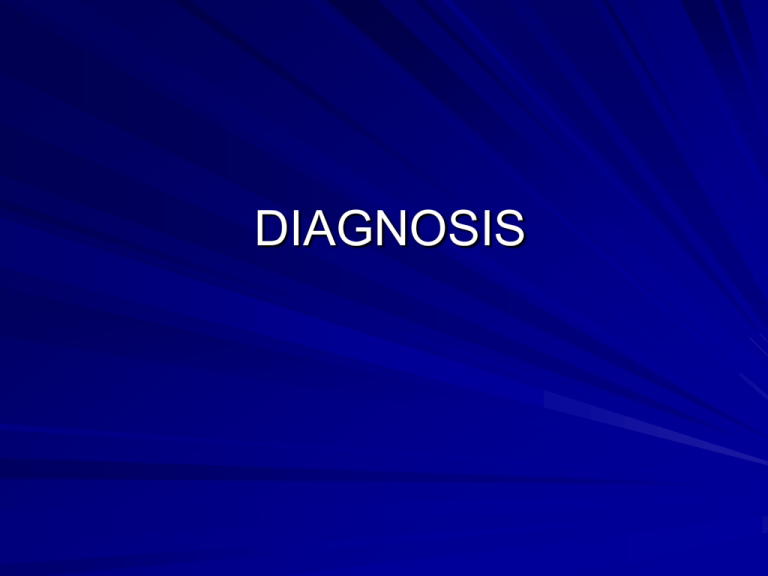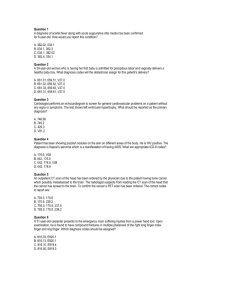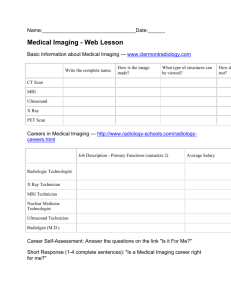Diagnosis
advertisement

DIAGNOSIS Purpose of Diagnosis To develop understanding plus a set of critical issues – Usually problems or threats, sometimes opportunities – Small number - to provide focus – Issues that should be central and vital to top management – Both short- and long-range considerations – Framed as issues, rather than solutions Diagnosis Overview Current mission, strategic objectives, & strategies Performance Scan & analyze external environment – Task (Competitive) environment – Societal (General) environment Scan & analyze internal environment – Need to break up into manageable pieces – Two main ways: Value chain analysis Functional area analysis Critical success factors S.W.O.T. table Set of “Critical Issues” Scan & Analyze External Environment Have to be selective and smart in scanning Competitive Environment – Porter’s 5-force model of the industry competitive environment General Environment – Technological – Political-legal – Economic – Social-cultural Stakeholders (within above and others) "Awareness of the environment is not a special project to be undertaken only when warning of change becomes deafening.“ (Kenneth R. Andrews) "It is not the strongest of the species that survive, nor the most intelligent, but the ones most responsive to change.“ (Charles Darwin) The key point is that an organization needs to be in tune with its often turbulent external environment Since there is so much happening in the external universe, we have to be selective and smart in scanning: • "Things are always different -- the art is figuring out which differences matter." (Laszlo Birinyi) • For a given industry (sometimes is country, industry, company-specific), certain aspects of the external environment tend to be more important and should receive primary attention • It helps to scan initially fairly quickly, then zoom in on areas where something of importance seems to be happening Key Strategic Questions What are the industry's dominant features, especially economic ones? What is competition like and how strong are each of the competitive forces? What is causing the industry's competitive structure and business environment to change? Who are the major competitors and what are their relative competitive strengths? What strategic moves are rivals likely to make next? What are the key factors for competitive success? Is the industry attractive and what are the prospects for above-average profitability? Porter’s 5-Force Model Rivalry Among Existing Firms Potential New Entrants Substitute Products or Services Bargaining Power of Suppliers Bargaining Power of Buyers General Environment Although usually only a few factors and trends are important, it is important to identify them Is useful to think of four main aspects of the general environment – Technological – Political-Legal – Economic – Social-Cultural Stakeholder Analysis What is a stakeholder? We need to be selective, consider MAJOR stakeholders: – Power – Interest Identify topic (usually a change) for analysis Identify major stakeholders Determine their degree of support or opposition to the action or change Assess the balance of support If not sufficient, work on changing – Decrease larger opposing forces – Increase supporting forces Ideas re how to do this? Where We Are Diagnosis overview Scan & analyze external environment Scan & analyze internal ◄ – Mission, objectives, strategies, performance – Functional areas: Financial Marketing Production/operations Technology Organizational Mission, Objectives, Strategies Identify and evaluate – Consistent – Current – Appropriate – Implemented well – Effective (performance vs. objectives) Internal Diagnosis In either value chain or functional area analysis: – Subdivide organization into several segments – For each, identify what is being done, how well it is being done, strengths and weaknesses – Examine linkages and potential synergies among various value chains & their segments, and/or among functional areas – Look for opportunities to improve and create sustainable competitive advantages Value chain and functional area analysis differ primarily in the way of subdividing the organization (to aid analysis) Value Chain Functional Areas Inbound logistics Operations Outbound logistics Production/operations Marketing & sales Service Marketing Human resource mgt. Infrastructure Procurement Organizational Financial Technology Technology Financial Financial Diagnosis Do not need exotic skills for our purposes Do need to do more than generate numbers and comment on trends ...need to EVALUATE & DRAW CONCLUSIONS Analyze Historical Have initial data (balance sheets & income statements for several years) Need to develop conclusions about financial health of organization – Are there significant strengths or weaknesses? – Implications for strategy formulation & implementation? How can we get from data to conclusions? Calculate some financial ratios Analyze trends Compare with other companies or industry Develop and state conclusions – Overall financial condition – Specifics, especially problems Also Look at Future Primarily to estimate needs and potential sources of strategic funds Can get perspective even from a simple forecast model Could use Index of Sustainable Growth What are major sources of additional financing? Marketing Functional Area Marketing Diagnosis Four P’s: – Product – Price – Place – Promotion Product portfolio analysis Marketing Growth Options Existing Product Expanded New Existing Market Expanded New Positioning & Competitive Strategy Competitive Advantage Lower cost Differentiation Competitive Broad Scope Narrow Price leadership Differentiation Price focus Differentiation Focus Learning About a Model A model is a tool, something to help you do some aspect of strategic management WHAT does the model help you do? What FACTORS or variables does it consider? HOW do you use the model? Limitations, etc. Note that a picture of the model is less important Product Life Cycle Production/Operations Production/Operations Often neglected Much of COGS here Also large effects on competitive position Key Strategic Decision Variables Locations & capacities of facilities Planning of output (what, where, when, cycles, continuous/intermittent...?) Flexibility (economies of scope) Efficiency Labor/capital intensity (operating leverage) Inventory levels (raw, WIP, finished goods) Quality Experience Curve Typical Price/Cost Pattern Technology Technology (R&D) Tie to technology developments in external scan Note successive S-curves (product performance vs. R&D expenditures) Key to competitiveness is when to shift resources to different technology Major Strategic Variables Technology strategy – Technology position – How we obtained & maintain position Buy or build Funding levels Basic/applied, product/process Application Technology transfer Trends, threats, what competitors are doing Organizational Key Organizational Factors Top management resources BOD situation Employee (labor) relations Structure (change needed?) Reward systems Culture Information systems Human resources systems... Key Success Factors In any industry there are certain key variables that significantly affect competitive positions Vary by industry Vary with life cycle of an industry For example, technology early in PC industry, now price (cost efficiency) Finish Diagnosis SWOT table (list) Critical Issues – Central & vital, typically 2-4 – Usually problems or threats, sometimes opportunities – Both short- and long-range considerations – Framed as issues, rather than solutions







